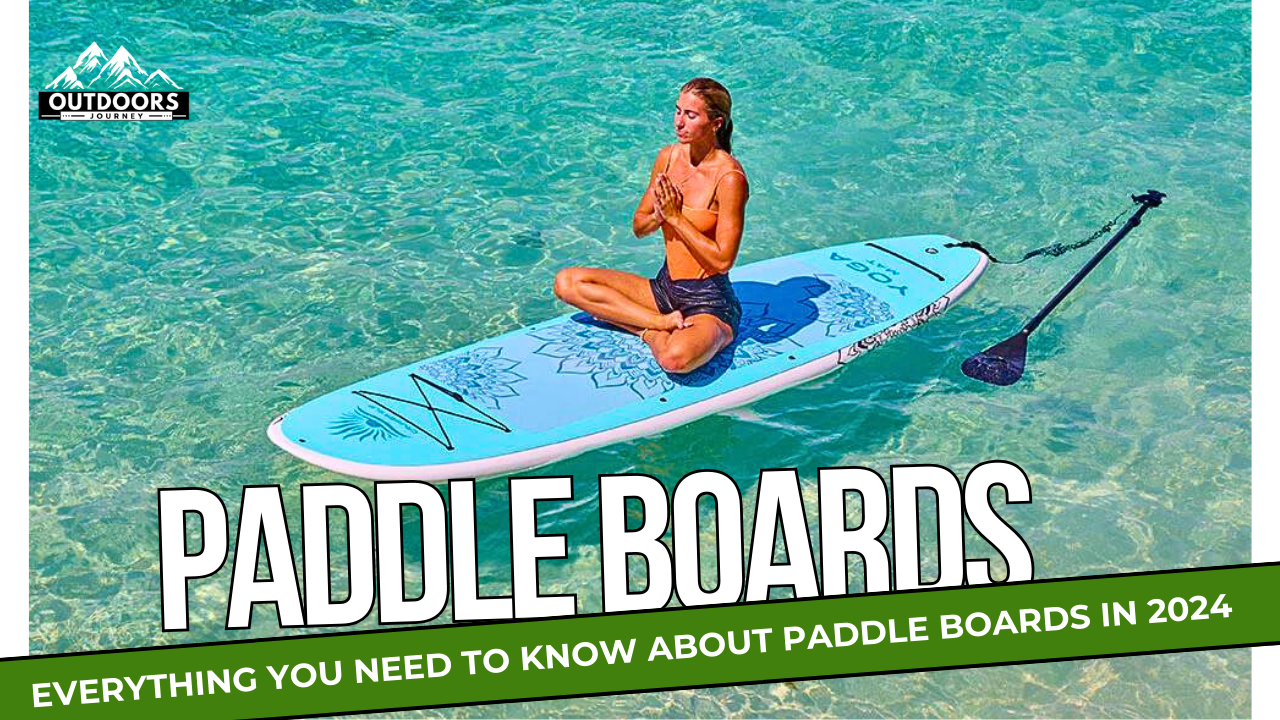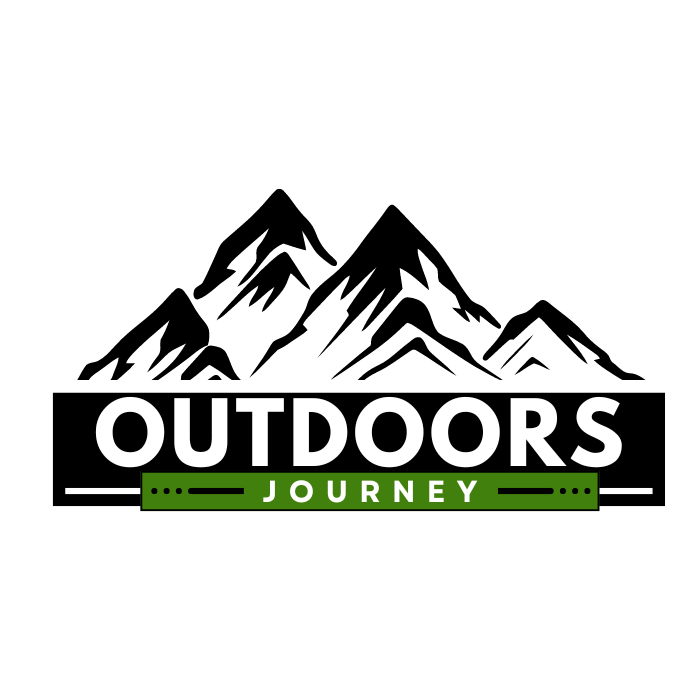Do you remember the first time that you stepped onto a paddle board? It was thrilling and yet the gentle sway of connecting with water… calming.
Stand-up Paddle Boarding: Stand-up paddle boarding has become one of the most popular water sports that is loved for its fun and pure versatility.
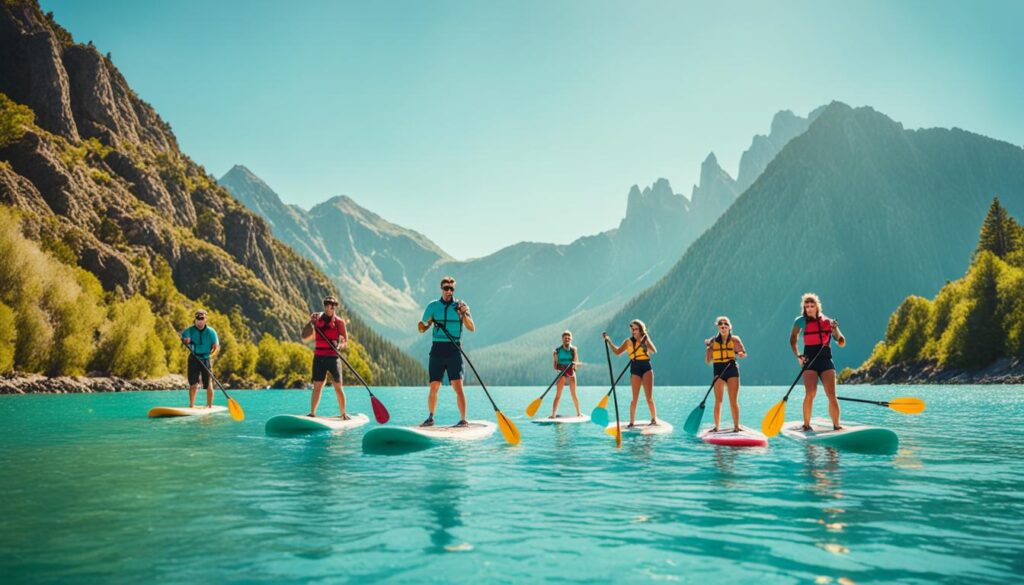
By 2024, narrowing down which SUP is right for you felt like trying to decide what your favorite candy was in a sweet shop.
No matter what kind of paddling you do, whether cruising flat water or branching out to the waves…it covers paddle board selection well. Live the freedom of water, create a moment, and magnify an experience.
Key Takeaways
- Paddleboarding is the fastest-growing water sport worldwide and has become very popular in recent years.
- Strong price war since many new brands join the inflatable paddle board business
- There are different boards for every activity, from SUP surfing and yoga to racing.
- Sizing, shape, and purpose: Picking the paddle board that is right for you
- High-end clearance or open-box models may be a more budget-friendly compromise.
- 1 2024 Brings A Rise In Paddle Boarding
- 2 Know About the Types and Benefits of Paddle Boards
- 3 Select the appropriate Paddle Board
- 4 Advantages and Disadvantages of Inflatable Paddle Boards
- 5 The Anatomy of a Paddle Board
- 6 Paddle Board Materials and Construction
- 7 Popular Paddle Board Brands in 2024 (all-around board)
- 8 Best Paddle Boards for Beginners (all-around board)
- 9 Pro Paddle Boards for All-Pro Boarders
- 10 Paddle Board Accessories You Should Invest In
- 11 Learn The Various Techniques Of Paddle Boarding In Different Conditions
- 12 Paddle Boarder Safety Tips
- 13 Climate Matters for Paddle Boarders
- 14 Exploring Paddle Board Communities and Events
- 15 Summary
- 16 FAQ
- 17 Source Links
2024 Brings A Rise In Paddle Boarding
Seems the world has gone paddle boarding mad. Paddle boarding is one of the fastest-growing water sports and even if some mix it up with madder pursuits, we think this will continue to gather pace in 2018 and beyond!! Over the past few years, it has experienced a massive growth in entrants. Today, approximately 3 million people paddleboard recreationally one or two times per year.
It shows how light-hearted and enjoyable a sport it is to so many people. The paddle board community has exploded as well. Paddle UK groups saw their membership increase from 32,000 to 90,000 in just ‑1/2 years.
Paddleboarding is being discovered by more and more people. This, in turn, brings yet more events and clubs….dojo culture increases. She says it illustrates that everybody is “getting into paddleboarding.”
Its ease of entry is one major factor in its ballooning popularity. Easy to get you in the water, even if you are a new player. In North America, the use of paddleboards dominates with 36.4% of the total market. There is also strong growth in Europe mostly driven by France, Italy, and the UK.
Paddleboarding is no easy feat, however. For instance, RNLI data shows three in five calls to assist paddleboarders stem from strong winds and currents. However, new tech and a loyal heart in the form of folks like you will help paddleboarding still edge up again in 2024.
Know About the Types and Benefits of Paddle Boards
There are several kinds of paddle boards, each geared towards a different type of activity and experience. I became aware very quickly — as a beginner, it was so important to know the differences. This is what can make them inflatable or solids. Knowledge of these types helps in choosing the right one as per your requirements.
All-Around Paddle Boards
What Are The Best All-Round Stand-Up Paddle Boards? Standing 9 to 12 feet long, they are stable and great for yoga as well in addition to fishing or just enjoying being on the water. These boards are well-suited for entry-level paddlers looking to feel more at home on the water.
Touring and Race Boards
If you like to paddle for miles and miles, touring boards are a good choice. Speedy and long from 11-6′ to 12-6′. They make for a better paddle when going long distances. They are more focused on racing boards, so they tend to be narrower and longer (perfect for racers).
Surf Paddle Boards
Surf Paddle Boards– Surf paddle boards are really made to travel the tides of sea waves. They are 6ft to a maximum of 10 ft — with pointy-snout type nose structures for breaking through waves. Ideal for the paddling/surfing combo, they perform well also in rough conditions.
Inflatable vs. Rigid Paddle Boards
An inflatable paddle board can also be pumped up with a really simple hand pump and is light to carry. They are rugged and good for first-timers. Rigid composite solid boards, as just described, do well in competition but are very difficult to transport.
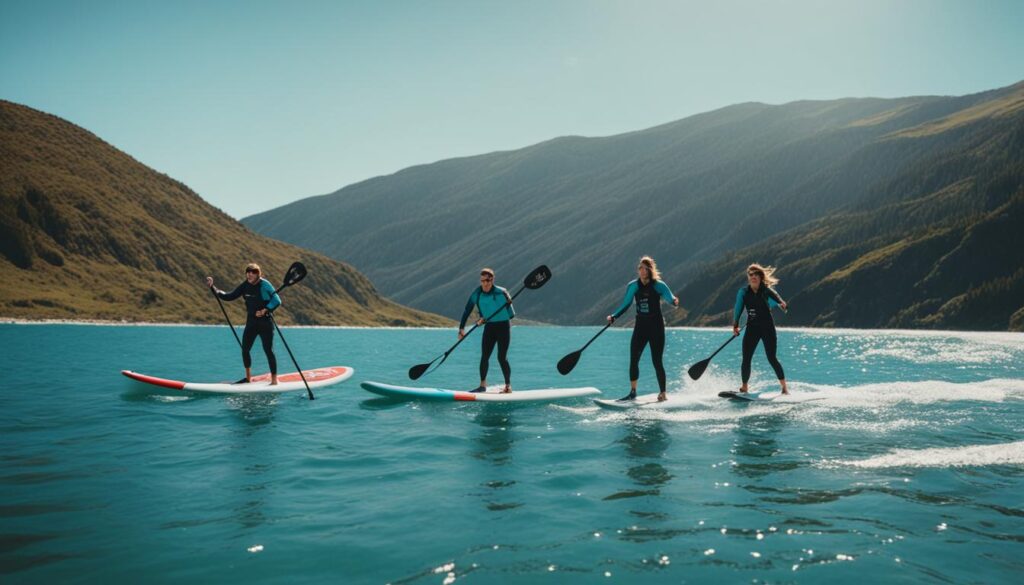
The decision of which would be right for you to buy depends on what type of paddling you’re going to do, and the budget that you have happy waiting inflateing. Contemplating those kinds of things is far more entertaining than daydreaming about barges.
Select the appropriate Paddle Board
Needless to say, choosing the best paddle board is crucial for your water adventures. I am new or I want upgradation. Knowing what to search for allows me to pick a solid board that suits my tastes.
Factors to Consider Before Buying
So let me start with how I intend to use the board. If I seek stability and security, a wider board is ideal for me. If you are new to the paddleboarding world, we recommend inflatable and all-around SUPs as they tend to be easier with beginners. Between 32” and 34”, those are the perfect wide boards(wider boards) for beginners. In addition, the shape of the board, for example, a rounded or partially curve-like surface will help me as well.
Skill Level and Board Selection
When selecting a paddle board, your ability level is essential. Stable boards are the way to go for beginners as they will help you feel confident on water. But when I get better, maybe a narrow Fast board for speed and flick. With this in mind, I can also choose the best type—the inflatable board is suited for someone who wants to pick up surfing as a beginner or an intermediate rider because of its lightweight characteristics.
Here’s a summary of crucial board selection tips:
| Feature | Beginner | Intermediate/Advanced |
|---|---|---|
| Board Type | Inflatable, All-Around | Touring, Racing, Surfing |
| Width | 32”-34” | Up to 33” |
| Shape | Rounded | Performance-oriented |
| Weight | 20-30 lbs | Varies by type |
By using these tips, I can pick the perfect paddle board for my goals and skill level. This ensures I have a great time on the water.
Advantages and Disadvantages of Inflatable Paddle Boards
Understanding the pros and cons of inflatable paddle boards is important for paddlers if they want to get out into the most challenging waters in comfort with one. In addition to that, they are also incredibly easy to store and move. You can deflate them and roll them up — packing is easy into a closet or backpack! Awesome and great for apartment dwellers or while you are traveling. It is space-saving and can help you save on rental costs when traveling as they are just like luggage.
Convenient to store and transport
Air boards about how easy, the storage of inflatable boards is truly convenient. These can be shelf-stable or tucked away and forgotten about without a second thought. They are light and can be carried, which is much more convenient than an oversized rigid board. And being able to travel with an inflatable board and not be concerned about taking dings during your river adventure is a huge benefit indeed.
Stability & Performance vs Rigid Boards
One of the biggest advantages is that inflatable paddle boards tend to be more stable than their rigid counterparts. A good quality inflatable board that sits thick and sturdy can take on a lot of weight before it begins to flex under body mass and feel sturdier. While they are not as stiff as your average hardboard, a good inflatable fully inflated can perform just the same. These are considerably slower than fiberglass boards, though most people do bias the rating on Fiberglass too high- they’re certainly good enough for casual use.
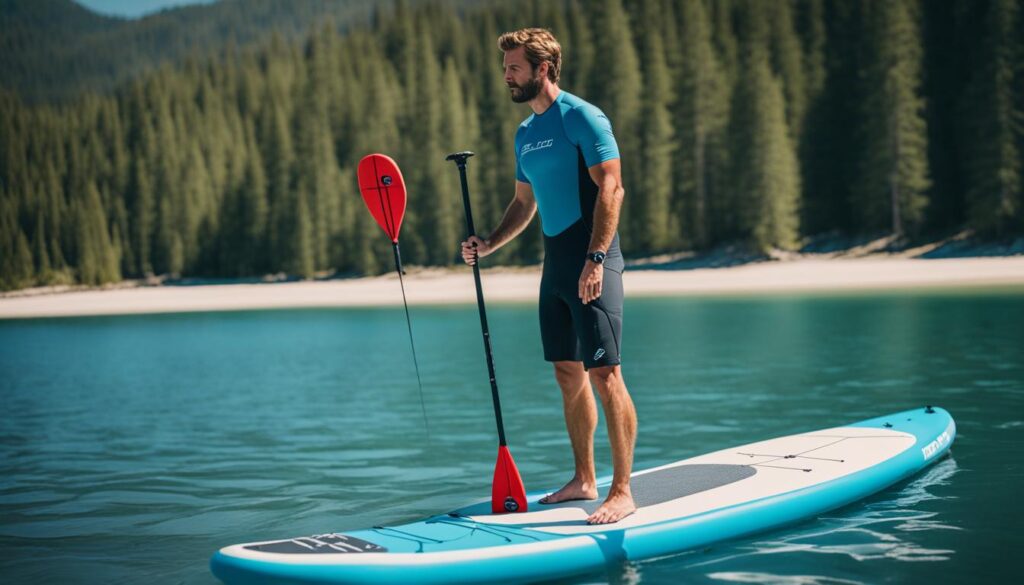
However, this can result in the board not being inflated properly and subsequently bending too much for heavier riders. Naturally, inflatable SUPs aren’t race boards by any means ( they’re not intended to be), but stability and convenience are the biggest advantages of using an inflatable board. Great all-around paddling and lounging on the water. All of this aside, it really comes down to which you like and what your use case for them might be — a decent balance between simplicity and power.
The Anatomy of a Paddle Board
Understanding the paddle board anatomy will make your paddleboarding experience so much better. All are important for better performance and function. The hull shape will also influence how the board moves in water. For Touring And Racing dorsal, A pointed nose is good while a wider nose will help beginners to stay stable.
Deck what keeps your feet from slipping all around when you are paddling. The board is often textured to provide a surface that makes it harder for toes to slip. It keeps you centered, especially when the water is choppy. Fin Setup — this also affects stability and tracking. If you are new to SUP, the one-fin is worth researching but if you are one of the experienced paddlers we suggest looking at a three-fin set-up for maximum tracking.
High-Pressure Valve: this is a feature commonly found on inflatable boards, usually it’s either Boston or Halkey Roberts. This combination of technologies serves to maintain the board structure and add a great deal of float. Boards are normally about six inches in thickness which affects the board stability and speed. Dug-out shapes are becoming popular in some new designs, such as for a deck. They will also help you in terms of your posture and just how effectively you move through the water.
Paddle Board Materials and Construction
Paddle board materials and construction methods are very important in how a paddle board will feel on the water, while you’re out paddling. Information on the difference between single-layer vs double-layer boards and how they make paddle boarding better for you.
Single-Layer or Dual-Layer
Single-layer boards are lightweight, less expensive, and ideal for the casual user. They are portable with a weight close to 30 pounds, though this can run anywhere from 15 up to about 40 lbs. They are of a higher quality than the inflatable tower paddle boards. Dual-layer board products, such as Tower Paddle Boards, can provide more stable performance since they won’t flex while you move around on them They provide more stability and performance through different situations.
Reaching a broader audience instead, the vast majority of SUP brands concentrate on single-layer or fusion construction. Consider how the weight will influence your decision. One question regularly asked is if lighter boards are less stiff, and also whether heavier dual-layer boards can manage tough use without a performance loss.
Why Does The Board Thickness Matter?
Key to max weight capacity & stiffness is board thickness The best inflatable SUP can hold up to 400 lbs thanks to their thickness and materials. They are the fact hard paddle boards can only carry 200 to 300 pounds. Due to its capacity, it makes it difficult for those who exceed this weight otherwise use fate in your own home or private grounds where no one else is around and all eyes go against you when appear with an EXEC board of surfer soul…. Holy cow!
Proper thickness reflects durability, maneuverability, and steadiness. This information assists you in selecting a board that suits your paddling style and requirements.
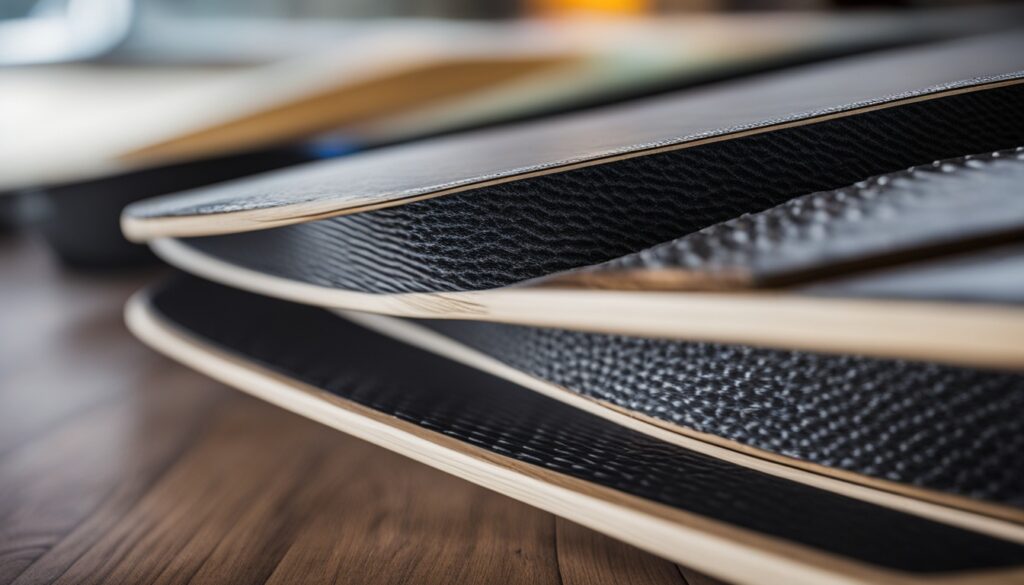
Popular Paddle Board Brands in 2024 (all-around board)
Paddle boarding seems to have grown in popularity these days amongst nature enthusiasts. Brands that are ahead of the line with their quality and performance in 2024. Top brands for paddle boards: BOTE, ISLE, and Surftech are three leading names in the field of paddleboards. These are meant to accommodate various levels of skill and different tastes.
Overview of Leading Brands
BOTE is in the queue with its trend-setting designs and robust construction. Cody adds some perspective in that the BOTE LowRider Aero is “a lot of board, 10’6″ x 36″ and only weighing in at a scant thirty pounds.” Good for most water conditions ISLE Paddle Board Style The ISLE Explorer 3.0 — rustically designed yet lightweight at a mere 24 pounds and capacity rated for an additional user up to the same weight, clearly focused on value-based quality agreed upon by members of their target demographic. The high-performance seekers are definitely going to love what the new Surftech is serving up. The Surftech Lido is 10’6″ x 32″ x 5″, and comes in at an identical weight capacity of 300 pounds.
Best Budget Options
Cheap Paddle Boards Concluded Conclusion…The ROC Kahuna Inflatable Paddle Board Is The Bottom-Line Winner For Price & Quality PRICING: BOTE 2024 Breeze Aero Classic – Budget Pick $799 Being 10′ 8″ long and having a width of 33″, it is designed for stability. This makes the board ideal for somebody just entering into this sport as well. This means that you will have an easy time looking for a cheap paddle board, due to all of the different options out there.
All-rounder inflatable boards that are great for all users They are light, only 18 pounds but can hold up to 350. These brands offer excellent paddle boards for a fantastic experience on the water.
Best Paddle Boards for Beginners (all-around board)
Buying the Best Paddle Boards for Beginners is Fun. Your ankles will thank you: try to find stable boards that are a breeze for beginners. Go for light frames: Boards Beginnersangular a design with lighter weight materials is one that will be generally easy to land on hassle-free because of its low center, as opposed to big wheels, juggles fun, but the best thing is that won’t have super heavy set-up getting usedStarterscruise deck. For beginners, boards that range in size from 10 feet 6 inches to up around the 11-foot mark make a really good first board.
Features to Look for in Beginner Boards
Features to Look for When Buying Beginner Paddle Boards:
- Stability: Boards like the Isle Pioneer 2.0, which is 34” wide, offer great stability for new users.
- Lightweight: Choose boards that are under 24 pounds for easy handling, like the Sea Gods Elemental Wave CX at 18 pounds.
- Easy Inflation: The Isle Pioneer 2.0 inflates in just four minutes, so you can spend more time on the water.
- Weight Capacity: Boards with a capacity of 240 lbs to 400 lbs offer versatility.
Recommendations for Entry-Level Paddle Boards
Here are some top picks for beginners:
| Board Model | Length | Weight | Width | Weight Capacity | Price |
|---|---|---|---|---|---|
| iROCKER Cruiser Ultra 2.0 | 10’6″ | 21 lbs | 32” | 400 lbs | Under $500 |
| Isle Pioneer 2.0 | 10’6″ | 24 lbs | 34” | 400 lbs | Approximately $400 |
| iROCKER Nautical 10’6 | 10’6″ | 22 lbs | 32” | 330 lbs | Approximately $300 |
| Blackfin Model X | 10’6″ | 23 lbs | 33” | 450 lbs | Approximately $599 |
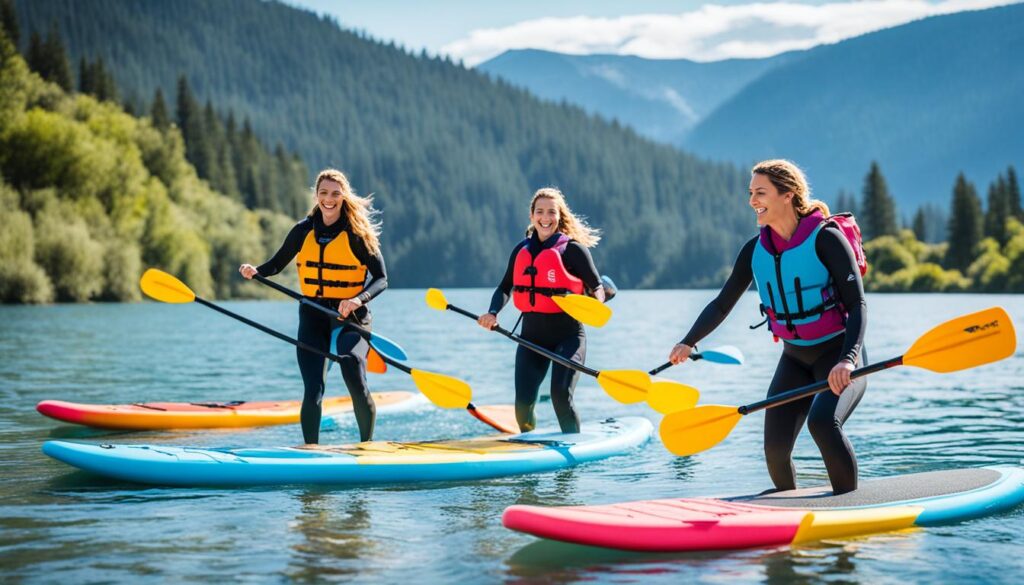
These options are more robust and cater to a wide variety of paddling styles. We have a plethora of beginner renters who start with their paddle board.
Pro Paddle Boards for All-Pro Boarders
Selecting the best quality advanced boards can benefit paddle boarding lovers too. These are designed for the performance Stand Up Paddler who wants maximum speed, agility, and stability. They improve your paddling performance, and they make time on the water more enjoyable.
Advanced Boards Performance Features
Premium paddle boards include: For the experienced enthusiasts They are designed to let you run faster, and change direction more rapidly. For instance, the 11’2 model is light yet they are able to handle large paddlers. Ideal for competitors
They are built using high-density foam for support, and reinforced with a strong material like carbon fiber. Pros: Due to the width, these are well-suited for beginner paddlers trying to improve their skills.
Advanced Feature for Racing Paddleboarding
Competitive paddle boarding stability and straight tracking speed boards. The best boards for races have high stability and speed as two of their strengths. Accessories include a carbon hybrid paddle to increase stability and speed.
This model is also ideal for various water types including the ocean. The more I discover, the less frivolous they seem. They make me improve in competition.
Paddle Board Accessories You Should Invest In
The perfect paddleboard accessories make my time on the water more enjoyable. A good paddle-boarding session is all about safety, comfort, and ease. For a day of surfing, there are some things you need to take with you.
Not all Personal Flotation Devices (PFD) are created equal

For me, PFDs are essential for paddle boarding. There are so many different styles and price ranges, that make it suitable for all kinds of water sports. My PFD is light enough that I can easily move without feeling uncomfortable. One of my essential paddle board accessories
Our Paddle Holders and Repair Kits
I love the paddle holders — they keep my paddle from taking off on me. Essential items to have for making small repairs are repair kits, especially in the event you own an inflatable board and it gets a hole. Those are the tools that keep me prepared for any unforeseen problems when I’m out on the water.
Pumps and Leashes
The board takes some work to inflate though, requiring a manual or electric pump. Leashes are just as important, keeping my board near me and adding a degree of safety in strong currents or windy days. Combined, these accessories keep me in command and make the paddling experience a much more enjoyable exercise.
| Accessory Type | Purpose | Importance |
|---|---|---|
| PFDs | Provides buoyancy and safety | Essential for all water activities |
| Paddle Holders | Secures paddles when not in use | Convenience and accessibility |
| Repair Kits | Fix minor damages | Prevents disruptions during outings |
| Pumps | Inflate the paddle board | Necessary before paddling |
| Leashes | Connects rider to board | Increases safety and control |
Learn The Various Techniques Of Paddle Boarding In Different Conditions
As to all paddle boarding strategies, knowing different tips and techniques is fundamental. My experience can be different knowing how to paddle in either flat or choppy water.
Flat Water vs. Choppy Water
Flat water!!! doggy, be smooth and consistent. This allows me to have the stem on a longer leash using fewer strokes. On choppy days, I take shorter strokes and make sure to crouch so that my positioning is maintained. Also, when times are tough I can make the best use of power stability and control whilst using my core.
Adapting Techniques for Various Bodies of Water
I have to vary the way I SUP depending on conditions. To avoid starting on my back, I transition onto all fours — then up to surf stance. Not to mention, I also wanted the paddle length that made sense for me — like a 10ft board if am under 170 lbs or an 11 ft one if I’m larger. For choppier water, the little waist-cinched does an okay job controlling and stopping a board from floating back. It is all about staying balanced, and if you know when to switch up your form then it makes paddle boarding so much more enjoyable.
Whether it’s calm lakes or rough seas, my paddle boarding techniques make a big difference.
Paddle Boarder Safety Tips
For a great day of paddle boarding fun, safety on the water is most important. In this entry, I will share with you some of the key safety gear and guidelines to prevent me or others from getting injured. You can observe these precautions, which will mostly eliminate the risks of this activity.
Essential Safety Gear
Wearing the right safety gear is a must. About 74% of paddle boarding accidents happen without proper safety equipment29. I always make sure to have these items:
- Personal Flotation Device (PFD): Colorado boating laws require adults to have a PFD on board, and kids 12 and under must wear one.
- Leash: A leash keeps me tied to the board, so I don’t get lost if I fall.
- Communication Device: Only 18% of paddle boarders have a way to call for help in an emergency. It’s crucial in a pinch.
How to Stay Safe on the Water
After the night is over, I look up by sunrise like just 37% of paddlers do. Notably in areas with strong currents or at river mouths, you had best understand local conditions and tides (stay 200m clear). In addition, paddling with a buddy reduces the risk of accidents by 70%, so rest assured I either have someone in tow or not on alone.
Stay aware of your surroundings while on the water. I baby photographers pay for the water temperature, as over 56% of paddle boarders do not and this increases hypothermia danger. Also, practicing rescue skills will reduce the safety risks that come with paddle boarding.
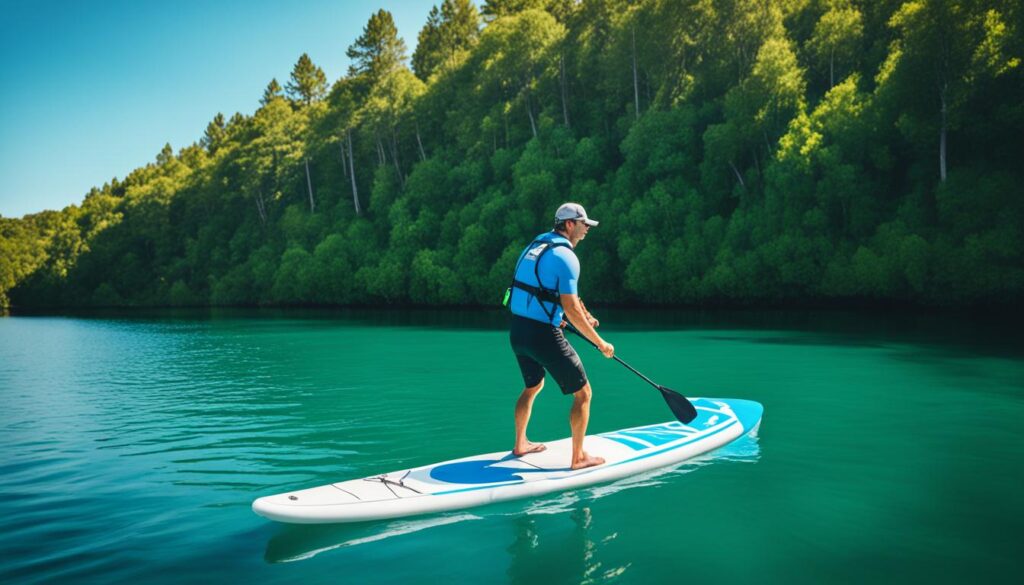
Climate Matters for Paddle Boarders
Being an avid paddler, I understand the importance of environmentally responsible thinking. Paddle boards allow us to become part of nature as well. And if we must, do it in a sustainable fashion so that you are retaining the ecology which is only making your lives easy. Possibly, by eco-friendly tips and the Leave No Trace principles together, we may keep our waterways safe.
Leave No Trace Principles
It is important to practice the Leave No Trace ethos in order that our wild places remain pristine. Little things such as throwing trash away, not having bonfires in the forest, and being respectful of wildlife do really help. It Is Environmentally Friendly Apart from being a nice, gentle way to paddle around on the water (compared to say blasting along at high speeds if you were jet-skiing or power boating), paddle boarding is more environmentally friendly than motorized sports. Gravel Gear uses better materials, so you can feel a little less guilty when polluting clean waterways.
Protecting Local Ecosystems
Photo by Frany FrancoisThere you have a Hands-on Surf eco-tour experience! Paddle boarding is also educational, allowing kids to learn about such environments as wetlands and coral reefs. Quietly plodding along the water is a kinship with nature, all help in not scaring marine animals. Beach cleanups and plastic collection: making our habitats cleaner for the animals, promoting conservation. Together we can get the word out about plastic pollution and climate change. This will ensure that we decrease the chances of pollution in our rivers and creeks, as well as the marine environment being safe for some years to come.
| Eco-Friendly Actions | Description | Impact |
|---|---|---|
| Using Sustainable Boards | Selecting boards crafted from biodegradable or recycled materials. | Reduces carbon footprint during manufacturing. |
| Leave No Trace | Following guidelines to minimize human impact on natural areas. | Protects wildlife habitats and preserves cleanliness. |
| Participating in Cleanups | Engaging in organized beach cleanups and wildlife protection. | Improves ecosystem health and reduces marine debris. |
| Advocacy and Education | Promoting environmental responsibility in the paddle boarding community. | Increases awareness and can influence change in behaviors. |
Exploring Paddle Board Communities and Events
The benefits of joining a paddle board community This will enable the game more enjoyable and interesting. Elsewhere: Participating in local clubs means I can be friends with new people and also take advice from experts.
This helps to make the place supportive for anyone and everyone who decides they want a piece of this paddle boarding lark.
Becoming a Member of Nearby Paddle Board Clubs
Soon I’ll become a local paddle board sponge, soaking up all the fun from one club to another. They have regular meetups where paddlers can get social. It could mean participating in group paddles and workshops so I can improve myself at paddle boarding while making cool friends along the way.
Competition/Events
I was able to participate in local paddle boarding events and test my skills against others. They unite us in our victories. I stay somewhat in shape, amateur races or charity events keep me mindful and I have great memories of longtime friends made within the paddle board community.
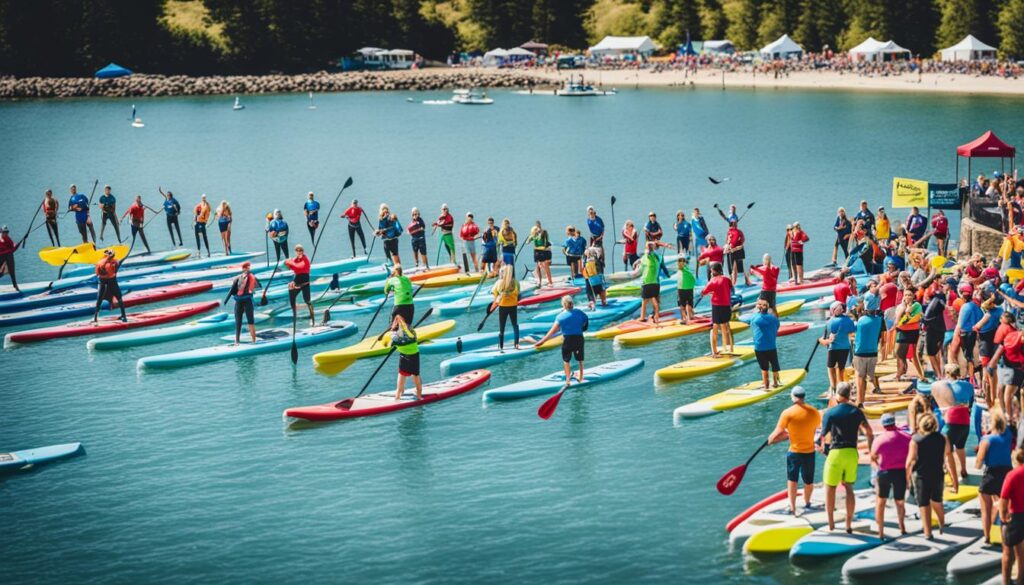
Summary
Paddle boarding is an actual sport, and as we come to the end of this guide on how to paddle board there’s something very important you need to remember… The move is a means for personal growth, sharpening problem-solving abilities, and enhancing one’s resilience on the water. It also gives us a better connection with nature and helps us feel more emotionally grounded.
Paddle boarding is for everyone, from beginner to expert. If that is not a people’s sport I do not know what it is. Safety first and selecting the right gear that entertains all ages is how I am ensuring my enjoyment in SUP.
When you are on serene lakes or virulent coastlines, paddle boarding has a number of fitness benefits; both good for your intellectual and bodily health. So let us all go and join our Paddleboarding community groupings here in UAE to save this Beauty of Nature. There is no better time to get started than now!
FAQ
What type of paddle board is best for beginners?
What are the advantages of inflatable paddle boards?
How do I select the right paddle board based on my skill level?
What materials are paddle boards made from?
Are there affordable options for good-quality paddle boards?
What safety gear do I need for paddle boarding?
How can I improve my paddling technique?
What community activities can I get involved with as a paddleboarder?
Source Links
- Stand Up Paddle Boards – Everything You Need To Know About SUP Gear – https://sup.star-board.com/paddle-board/
- How paddleboarding conquered Britain: the delights and dangers of the nation’s fastest-growing sport – https://www.theguardian.com/lifeandstyle/article/2024/aug/21/how-paddleboarding-conquered-britain-delights-dangers-nations-fastest-growing-sport
- Stand Up Paddleboard Market Size & Share Analysis – Industry Research Report – Growth Trends – https://www.coherentmarketinsights.com/industry-reports/stand-up-paddleboard-market
- Different Types of Paddle Boards | All You Need to Know – https://outdoormaster.com/blogs/om-blog/different-types-of-paddle-boards
- What Type of Stand Up Paddle Board is Best for Me? – https://www.cruisersup.com/pages/types-of-stand-up-paddle-boards?srsltid=AfmBOopHfG0I-7sRtf0KA5NuUsBW6lXgcaCNe288GRuu4KqidnghcXaq
- What Are The Different Types Of Paddle Boards – 20+ Paddle Board Types Explained – https://www.watersportswhiz.com/types-of-paddle-boards/
- How to Choose a Stand Up Paddle Board | ISLE | ISLE Paddle Boards – https://islesurfandsup.com/pages/how-to-choose-a-sup
- A Beginner’s Guide To Choosing A Paddle Board – https://www.pumpedupsup.com/blogs/news/a-beginner-s-guide-to-choosing-a-paddle-board
- How To Choose A Stand Up Paddle Board : Buyers Guide – https://www.paddlesurfwarehouse.com/stand_up_paddle_board_buyers_guide
- Inflatable vs. Hard Paddle Board – Which is Best? – https://www.pumpedupsup.com/blogs/news/top-7-reasons-to-consider-an-inflatable-for-your-next-sup-board
- Inflatable SUP Pros And Cons – https://isupworld.com/inflatable-stand-up-paddleboard-pros-and-cons/
- SUP Anatomy 101 – What Are The Basic Parts Of A Paddle Board? – https://www.watersportswhiz.com/what-are-the-basic-parts-of-a-paddle-board/
- Anatomy Of A Paddle Board | Academy of Surfing Instructors – https://www.academyofsurfing.com/news/anatomy-of-a-paddle-board—what-are-the-parts-and-what-do-they-do
- SUP Construction Explained – What Are Paddle Boards Made Of? – https://www.watersportswhiz.com/what-are-paddle-boards-made-of/
- iSUP Buyer’s Guide on Construction Quality – https://www.towerpaddleboards.com/blogs/pages/isup-construction?srsltid=AfmBOorTO00jbAiB3NjCbxfCG3Ho7lpuMZyVm8y29j3BmaxUQfy4mhRt
- The Best Stand Up Paddle Boards of 2024 | The Inertia – https://www.theinertia.com/gear/best-stand-up-paddle-board/
- The Best Standup Paddleboards of 2024 – https://gearjunkie.com/boats-water/sup/best-standup-paddle-board-sup
- The 10 Most Reliable and Portable Inflatable Paddle Boards We’ve Tested – https://www.travelandleisure.com/best-inflatable-paddle-boards-6754104
- Learn to Paddle Board with These Simple and Stable Options for Beginners – https://www.travelandleisure.com/best-paddle-boards-for-beginners-7644665
- Best Paddle Boards for Beginners, 2024 – https://www.supboardguide.com/best-paddleboards-for-beginners/
- Best Paddle Board (iSUP) for Beginners Tested and Reviewed | 2024 – https://www.inflatableboarder.com/best-paddle-board-for-beginners/
- EVO 2.0 – https://ecsboards-australia.com/products/copy-of-evo?srsltid=AfmBOorD5dUCErBDH9fmhPmp659kcGLE8NVy0xXZyh-WkdkMhz8N1S5U
- Waterwalker 132 All-Around 11′ Paddle Board | THURSO SURF – https://thursosurf.com/shop/stand-up-paddle-boards/waterwalker-all-around-sup-132/?srsltid=AfmBOor2r_YAj24U3kxGh6QgAd1yFMxGugIOB-x8fofatyM7pRl_XOx3
- Inflatable Paddle Boards | Inflatable SUP Boards | Blow Up SUPs | Hydrus Board – https://www.hydrusboardtech.com/collections/inflatable-boards?srsltid=AfmBOoqxLP0ZHoy_l63Y60Il3Am9VAxOIzVerhbmXAoWgWR-h6jeVG6L
- 25 Top Paddle Board Accessories: Needs & Fun-to-Haves – https://aquabound.com/blogs/resources/15-top-paddle-board-accessories-needs-fun-to-haves?srsltid=AfmBOorlpBDCBv0CseehHqdwOEyz0nCTw4qkFyRXQhOjUZR31MmgF-Wa
- Paddle Board Accessories: Enhance Your Stand-Up Paddling Experience – https://outdoormaster.com/blogs/om-blog/paddle-board-accessories
- How to Paddle | Stand Up paddle Technique | Basic Paddle Stroke – https://red-equipment.us/pages/paddling-tips?srsltid=AfmBOooVcjjGQRro8jx-jg0992VNTPzlC2uCCUfz6l1jn-r8Jl57s6EL
- How to Stand Up Paddle Board (SUP) | Ultimate Beginners Guide – https://koapaddleboarding.com/how-to-paddle-board/
- SUP Safety Tips | Staying safe on the water checklist – https://red-equipment.us/pages/sup-safety-stay-safe-on-the-water?srsltid=AfmBOooS6vXL_C2cBMZHem0FRDCl1sRuUQJG_2r2AEMiSsn8GWxiodeL
- Paddleboard Safety – Colorado Outdoors Online – https://coloradooutdoorsmag.com/2020/05/05/paddle-board-safety/
- 12 Safety Tips for Safe Stand Up Paddle Boarding | Academy of Surfing Instructors – https://www.academyofsurfing.com/news/12-safety-tips-for-safe-stand-up-paddle-boarding
- Stand Up Paddle Boarding and Environmental Conservation: A Sustainable – https://www.glidesup.com/blogs/general-paddle-board-information/stand-up-paddle-boarding-and-environmental-conservation-a-sustainable-way-to-enjoy-the-outdoors?srsltid=AfmBOorKMZV4NZCbux7rvp-ne5fD1o9Nfi3VHEOVPeeCcoMO6l3yP4hJ
- The Impact of Stand Up Paddle Boarding on Marine Environments and How – https://www.glidesup.com/blogs/general-paddle-board-information/the-impact-of-stand-up-paddle-boarding-on-marine-environments-and-how-to-minimize-it?srsltid=AfmBOorfbvZ0DptzzYcPBBObxEDkJj0bNWhnS2Fu4XiHd_a300p4VW5g
- The Environmental Impact of Paddleboarding and How We Can Do to Reduce It – https://wowseasup.com/blogs/news/the-environmental-impact-of-paddleboarding-and-how-we-can-do-to-reduce-it
- Bridging the Gap: How Paddle Boards are Bringing Communities Together – https://www.glidesup.com/blogs/general-paddle-board-information/bridging-the-gap-how-paddle-boards-are-bringing-communities-together?srsltid=AfmBOopKQaP95yxj_xixdefz1hq3W6R6uRiB5wHHUXyqsUxlluzUSSWi
- Paddle Boarding: The Essence of Life’s Balance – https://www.glidesup.com/blogs/general-paddle-board-information/paddle-board-philosophy-how-sup-reflects-life-lessons-and-personal-growth?srsltid=AfmBOoobQPLV80leDz0Ba5-BQFkdf087DGhCapJBl2aLqhTm1WqqV00O
- The physiological, musculoskeletal and psychological effects of stand up paddle boarding – https://www.ncbi.nlm.nih.gov/pmc/articles/PMC5057214/
- Introduction to Stand Up Paddle Boarding – https://www.surfinghandbook.com/introduction-to-stand-up-paddle-boarding/
